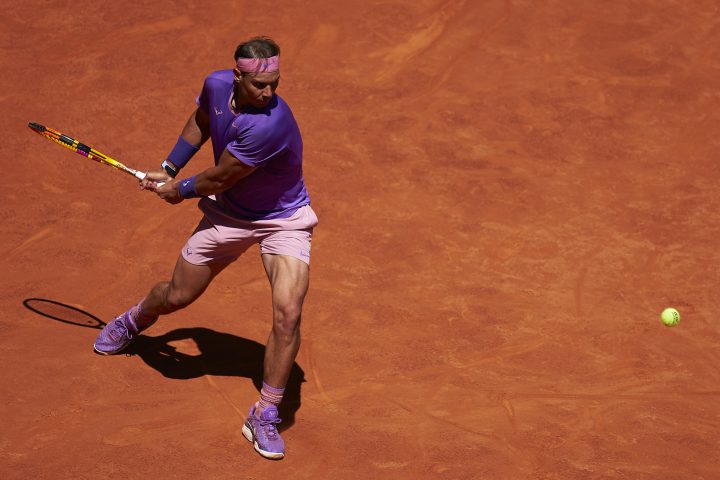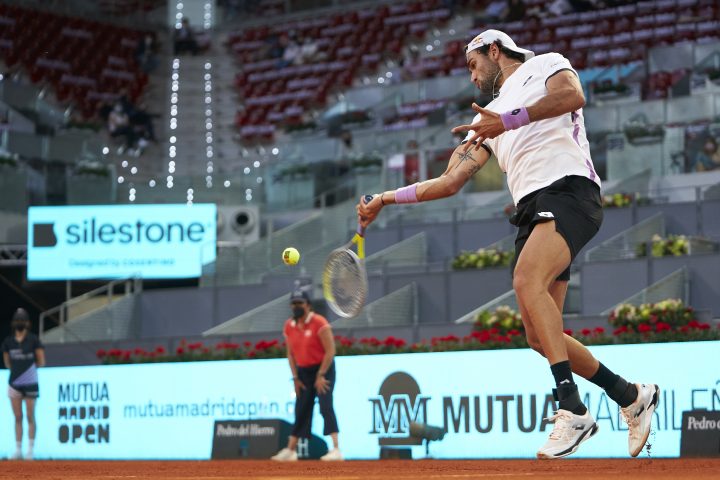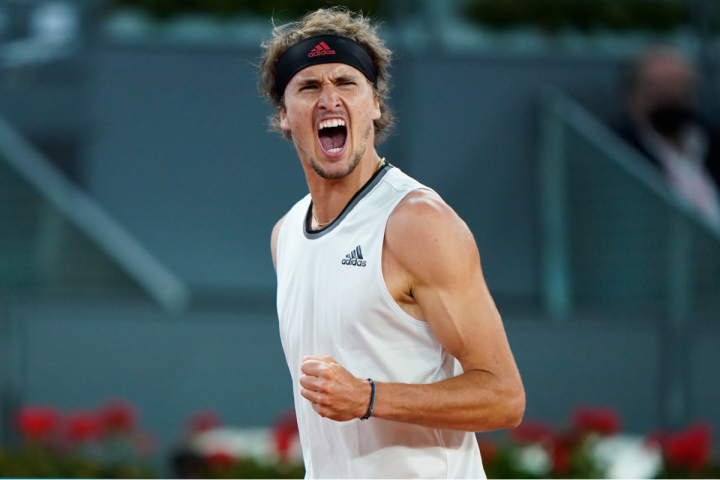We have been witnessing a fascinating clay court campaign in a multitude of ways over the last several weeks. The first major development was when Stefanos Tsitsipas secured his initial Masters 1000 crown in Monte Carlo by toppling Andrey Rublev in the final after Rublev had stunned eleven time victor Rafael Nadal in the quarterfinals. Novak Djokovic suffered an even more astounding upset loss there to Great Britain’s Dan Evans in the round of 16.
Then Nadal was victorious in Barcelona, capturing that highly regarded ATP 500 title for the twelfth time, rescuing himself from match point down in the final against an inspired and somewhat unlucky Tsitsipas, prevailing in three hours and thirty eight minutes of suspenseful and riveting tennis. That same week in Belgrade, Djokovic was beaten in the semifinals of an ATP 250 event in his homeland, narrowly falling short against the surging Aslan Karatsev. The following day, the top ranked Italian Matteo Berrettini ousted Karatsev in a final set tie-break to claim that title.
And soon the stage was set for the second clay court Masters 1000 tournament of the season this past week in Madrid. Once more, there were a good many surprises over the course of the week. For starters, 2019 champion Djokovic chose not to play. Tsitsipas was knocked out in the round of 16 by a perspicacious Casper Ruud. Overflowing with confidence coming into the tournament, Tsitsipas never found a way to contain Ruud from the backcourt. He seemed constantly ill at ease coping with the Norwegian’s heavy and penetrating topspin forehand. Ruud kept Tsitsipas at bay with his high bounding shots off that side.
That match turned late in a first set settled in a tie-break. That crucial sequence was locked at 3-3 when Tsitsipas punched a backhand volley long to give Ruud the mini-break. Ruud took control off the forehand to stretch his lead to 6-3, and then came through to take the tie-break 7-4 when Tsitsipas missed a forehand inside-in wide.
The second set went to 3-3, but Tsitsipas was broken at 15 when he double faulted and pressed off the forehand, netting his down the line shot off that side. Ruud was too good with the lead, holding at 30 for 5-3. Two games later, Ruud served for the match, meeting that challenge with temerity, holding at the cost of only one point. Victory was salvaged deservedly by Ruud 7-6 (4), 6-4, who connected with nearly 80% of his first serves and largely set the tempo in this meeting. He was so good that Tsitsipas was frequently discombobulated, pressing and beating himself down the stretch.
The Norwegian eventually lost in the semifinals 6-4, 6-4 to a top of the line Berrettini after ousting Alexander Bublik 7-5 6-1 in the quarterfinals. He is beginning to make a habit out of showing up for the latter stages of Masters 1000 tournaments. He lost to Djokovic last year in the semifinals of Rome and a few weeks ago advanced to the same round in Monte Carlo. Ruud has the game to keep advancing deep into these draws at elite events.
Meanwhile, Daniil Medvedev returned to the ATP Tour after being sidelined by Covid-19. He won a match but was then taken apart by the seasoned Christian Garin of Chile, a seasoned clay court player who was not intimidated in the least by taking on the world No. 2. He came through 6-4, 6-7 (2), 6-1 for perhaps the biggest win of his career. Medvedev looked out of sorts and ill at ease through most of this encounter. The 25-year-old Russian was candid both before and after losing about his inner confusion concerning how to make his game work effectively on the dirt. The 2019 U.S. Open finalist and 2021 Australian Open runner-up has never won a match at Roland Garros in four appearances. He will have his work cut out for him to recover his finest tennis this week in Rome.
Clearly the most pivotal moment of the week in Madrid was the quarterfinal departure of Nadal at the hands of Zverev. The Spaniard looked composed and secure on his way to the appointment with Zverev. He was outmaneuvering his tall adversary in the early stages of this contest, building a 4-2 lead, putting himself two holds away from taking the first set. He reached 30-30 in the seventh game but Zverev stung him severely with a pair of excellent passing shots to get the break back.

Down break point in the following game, Zverev gamely held on to reach 4-4. Nadal had a game point for 5-4 but he could not cash in on it. At deuce, he double faulted, and then he netted a backhand passing shot. Zverev was rolling now. Serving for the first set, he started with a double fault but swept four points in a row from there with a flourish, lacing a backhand winner crosscourt, coming to the net to pressure Nadal on the next two points, and then acing the Spaniard down the T.
Zverev had captured four consecutive games and he never looked back as a desultory Nadal could not recover his form. Zverev played beautifully and dictated his share of the points. His serve was magnificent as Nadal only broke him once. For his part, Nadal was far too negative once he dropped the opening set. He fell behind 4-2 in the second set and held on there from 15-40, but Zverev maintained the upper hand to win 6-4, 6-4, stopping Nadal for the third time in a row.
Nadal, Tsitsipas and Medvedev were not the only major casualties in the tricky high altitude conditions on the Madrid clay. Dominic Thiem— absent in Monte Carlo and Barcelona and moving through something of a mid-career identity crisis—managed to fend off the sport’s most fearsome server in John Isner. Isner had cut down both Roberto Bautista Agut and Rublev in final set tie-breaks and he nearly halted Thiem. But when the industrious Austrian erased four break points against him at 2-2 in the second set, he altered the course of the match and Isner’s soaring confidence was soon diminished. Thiem rallied admirably for a 3-6, 6-3, 6-4 triumph and a place in the semifinals.
That was not a bad start to his 2021 clay court campaign. But he looked rusty and uncomfortable against Zverev in the semifinals, and the 6-3, 6-4 scoreline is somewhat misleading. It was not as close as that. Zverev was far more self assured and consistent amidst the swirling winds and he had another very good serving day. He never allowed Thiem to settle into any kind of rhythm from the backcourt. The win for Zverev was all the more gratifying considering that it was their first clash since meeting in the U.S. Open final. Zverev led two sets to love in that match and later served for the match in the fifth set, but he faltered in the crunch and endured a nightmarish setback.
Not so in Madrid. On the clay he was often masterful, driving his two-handed backhand deep down the line for winners, opening up the court with his forehand, and approaching the net at all the right times to keep Thiem unsettled. He demonstrated in this match— as he had against Nadal—that he is as formidable on clay as he is on any other surface. Zverev was a worthy winner of the Madrid Masters 1000 tournament in 2018 after winning Rome the previous year. He also won the Canada hard court Masters 1000 tournament at Montreal in 2017. Those string of triumphs are abundant proof that he can win big tournaments as well as perform with comparable excellence on all kinds of courts.
For Zverev, the final this time around was a chance to reaffirm his greatness while Berrettini was searching for a breakthrough and a validation of all the progress he has made since he climbed into the world’s top ten in 2019 and reached the semifinals of the U.S. Open. He had never reached a Masters 1000 final before, but this was a chance to get on the board and prove that he belongs among the sport’s elite.
Berrettini acquitted himself well in a hard fought opening set. He gained the first break of the match for 4-3 but Zverev retaliated immediately to make it 4-4. They settled that set in one of the most bizarre tie-breaks of the entire tennis season. Benefitting from a stream of unforced errors from Zverev, Berrettini built a commanding 5-0 lead, with two service points to follow. But the Italian tightened up, losing the next four points, giving away three with unjustifiable mistakes.
Yet Berrettini unleashed a forehand inside in winner for a 6-4 lead, with two set points at his disposal. Once more with the lead, Berrettini faltered and Zverev moved in front on a run of three consecutive points, serving an ace for a 7-6 lead and a set point. But Berrettini produced a pair of fine first serves and took control off his explosive forehand to regain the lead at 8-7. Although Zverev made it back to 8-8, he foolishly gambled by going for a huge second serve ace down the T, double faulting that point away. Now Berrettini secured the set on his fourth set point with a service winner to the backhand.
The charismatic Italian had survived a considerable ordeal to salvage a set that almost got away, but Zverev refused to be preoccupied by an agonizingly narrow failure. Across the last two sets he was the decidedly better player. At 4-4 in the second set, Berrettini was burned by allowing Zverev to read his drop shot with ease. The German scampered forward and chipped a backhand winner out of reach for 15-40. Shaken, Berrettini double faulted and Zverev had the critical break for 5-4. Zverev served it out in the tenth game to make it one set all.

The Italian had one more opportunity early in the third set when he had a break point for 3-1 after Zverev went for another second serve ace down the T and double faulted. But Zverev saved the break point with a massive combination of a big serve that set up a forehand winner behind Berrettini. He held on for 2-2 and never looked back, breaking in the fifth and ninth games to record a 6-7 (8)), 6-4, 6-3 victory for his fourth Masters 1000 singles title. The only active players who have won more are Djokovic (36), Nadal (35), Roger Federer (28) and Andy Murray (14).
Most importantly at the moment, this was Zverev’s third Masters 1000 crown on clay. That puts him in very good stead for Roland Garros. Zverev now must be considered a top five candidate to take the world’s premier clay court title. Nadal remains the clear favorite, followed by Djokovic, Thiem and Tsitsipas. But Zverev is now right up there on the clay with the Serbian, Austrian and Greek stylists. Winning this title could not be more timely or uplifting for the tall German performer, with or without a strong showing in Rome this week.
Zverev coming through so convincingly in a tournament of such prestige only augers well for him in Paris. But what about Rome? Who is best positioned to be victorious this week on the Italian red clay?
Those are not easy questions to answer. One would think that Nadal will be very eager to make amends. He has won only one of his three clay court tournaments this year en route to Roland Garros, losing a pair of quarterfinals. Even his lone triumph in Barcelona was a narrow escape as the Spaniard saved a match point in the final set before holding back Tsitsipas in a rousing title round showdown.
This week in Rome, Nadal’s draw is not easy by any means. Seeded second behind Djokovic, he may have to face the hard working and wildly ambitious Jannik Sinner after a first round bye. He could meet Zverev for the second week in a row in the quarters. Zverev would have nothing to lose after eclipsing Rafa in Madrid, and the Spaniard could be both eager and uneasy if he does indeed face Zverev again.
If Nadal survives a potential confrontation against Zverev, he will be very likely to reach the final. No. 3 seed Daniil Medvedev is on his half of the draw. I don’t believe Medvedev will make it to the penultimate round, but perhaps Diego Schwartzman will break out of a recent slump of sorts and try to reprise his winning form against Nadal last year at the same tournament.
There is no doubt Nadal could use a boost going into Roland Garros. He has yet to strike peak form these last bunch of weeks on his favorite surface, but claiming a tenth title in Rome would do much to improve his state of mind and carry him into Roland Garros feeling more like himself.
And yet, as much as Nadal wants to raise the level of his game this week in Italy, Novak Djokovic is even more in need of a morale boosting tournament. Djokovic, of course, commenced 2021 in style with his ninth Australian Open title run and an 18th Grand Slam title victory. But in his two clay court appearances this spring, he has not found a winning formula.
In Monte Carlo, playing Dan Evans for the first time, Djokovic was way off his game in a straight set defeat. He then suffered the disappointing loss to Karatsev in Serbia. Those subpar results are precisely why Djokovic must be determined to win his sixth Italian Open this week—or at least reach the final. That will be no facile feat. He could meet Evans again in his opening match if the British competitor beats Taylor Fritz in the first round.
The seedings project that Djokovic will meet the No. 5 seed Tsitsipas in the quarterfinals (if Tsitsipas can defeat Berrettini), and that one could be a blockbuster. Also on his half of the draw for a potential semifinal encounter are Thiem and Rublev, who should clash in the quarterfinals. My feeling is that Rome is even more important for Djokovic than it is for Nadal; a great week in Italy could propel the estimable Serbian into Paris and make him believe in his chances to win Roland Garros for the second time, but an early round loss would be a serious setback.
So there you have it. I have a hunch that we are in for some more surprises this week. Rublev might explode and take his first Masters 1000 title. Zverev will be ascendant after his heroics in Madrid. He will be loose, confident and happy to be sparkling in the springtime. Perhaps it is asking too much of him to win back to back Masters 1000s in successive weeks, but perhaps not. I would also not be stunned to see Tsitsipas step back up after his loss in Madrid and put it all together again.
To be sure, Nadal must be the favorite this week. He can be exceedingly dangerous when he is disconcerted with his game, and that could well drive him to dizzying heights in Rome. I feel the same way about Djokovic. He has too much pride and professionalism to accept anything less than a stellar showing this week as either the champion or the runner-up.
But what makes it all so intriguing at the moment is the unpredictability of the last three Masters 1000 tournaments. Hubert Hurkacz struck down Sinner in the Miami final; neither player had ever been in a Masters 1000 final before. Tsitsipas took his first of these elite prizes in Monte Carlo by toppling Rublev in the final. And then Zverev triumphed deservedly in Madrid, coming from behind to oust Berrettini, who was appearing in his first final at one of these elite events.
So take nothing for granted. Look for Nadal to be almost defiant. Expect Djokovic to be as motivated as he has been in a long time. Be anticipating as well that one of the emerging superstars of men’s tennis will be in the thick of the proceedings and unafraid to confront the icons of the game at the second most important clay court tournament in all of tennis.
___________________________________________________________________________
Steve Flink has been reporting full time on tennis since 1974, when he went to work for World Tennis Magazine. He stayed at that publication until 1991. He wrote for Tennis Week Magazine from 1992-2007, and has been a columnist for tennis.com and tennischannel.com for the past 14 years. Flink has written four books on tennis including “Dennis Ralston’s Tennis Workbook” in 1987; “The Greatest Tennis Matches of the Twentieth Century” in 1999; “The Greatest Tennis Matches of All Time” in 2012; and “Pete Sampras: Greatness Revisited”. The Sampras book was released in September of 2020 and can be purchased on Amazon.com. Flink was inducted into the International Tennis Hall of Fame in 2017.






